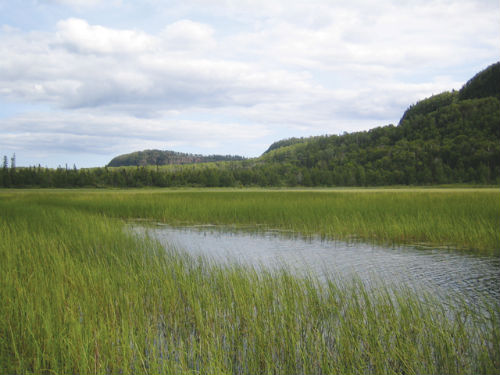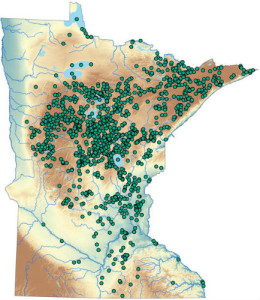Evaluating Minnesota’s water sulfate standard for wild rice

The Minnesota Pollution Control Agency is reviewing its standards for protecting wild rice in Minnesota. With funding from the Minnesota State Legislature, the agency conducted a two-year study to determine how sulfate—the presence of which in water has been linked to an absence of wild rice—and other chemicals affect the health of wild rice. The MPCA will ultimately use the findings to assess whether the sulfate standard for water needs adjustments—a question that bears important merit in the context of proposed mining operations (more information about mining is at the bottom of this article).
The MPCA adopted its sulfate standard for water in 1973, when it was also approved by the United States Environmental Protection Agency. The standard was based off of the work of Dr. John Moyle, who surveyed many of the waters across Minnesota during the 1930s and 1940s. Moyle wanted to understand the relationship between water chemistry and aquatic plants, and he found a correlation between the presence of sulfate in the water and the presence of wild rice.
“What came out of his work is that wild rice is generally uncommon in water above 10 parts per million of sulfate,” said John Pastor, professor and wild rice researcher at the University of Minnesota, Duluth. The MPCA contracted with Pastor to conduct parts of the study. “Moyle was correct but the problem was that he didn’t know why,” Pastor added.
The sulfate standard for water was set at 10 parts per million (mg/L). But in recent years, Pastor and MPCA scientists suspected that further research would yield more accurate information about the actual chemicals that harm wild rice. They suspected sulfide, which can be made from sulfate, to be the real culprit.

“We felt it was unlikely sulfate that was harming wild rice because plants pick up sulfate,” Pastor said. Anaerobic microbes in the sediment of wild rice beds turn sulfate into sulfide, which is a toxin. “Hydrogen sulfide is that rotten egg smell you get sometimes. It’s toxic stuff to life, not just to wild rice but you, me, everything.”
Ed Swain, MPCA Research Scientist, helped design the agency’s study, which sought to look at the effects of sulfate and sulfide on wild rice at three different levels: field research to survey lakes for various chemicals and wild rice; lab work to determine the effects of sulfate and sulfide on wild rice, and stock tanks that mimicked the conditions in wild rice beds. The latter allowed Pastor and his team to apply varying amounts of sulfate and track how much turned into sulfide, and how much that affected plant health.
“Our primary hypothesis was that sulfate is not toxic but could turn into sulfide, and that would be tough,” Swain explained. Thirteen university professors, seven federal representatives, six tribal members, five Department of Natural Resources representatives and five people of miscellaneous background commented on the plan prior to funding and implementation.
The scientists were correct—in the lab, sulfate did not adversely affect wild rice plants until 1,600 parts per million (ppm). By contrast, sulfide was toxic to young seedlings at a range of 300 to 700 parts per billion (ppb).
“That corresponded to what we saw in stock tanks. The more sulfate we added, the more sulfide we saw produced in the sediment right in rooting zone,” Pastor said. “We saw very reduced seedling emergence and seedling survival.”
The findings suggest that in reviewing the sulfate standard, the question becomes what level of sulfate will keep sulfide at levels low enough to protect wild rice. Pastor and his team calculated a narrow range. “We found that given the range of toxicity of sulfide for the seedlings we have to keep sulfate between 7 and 20 mg per liter to keep sulfide below toxic levels. There’s not a lot of wiggle room for the standards,” Pastor said.
But some findings from the experiment suggest that analyzing the standard may be even more complex than simply understanding the effects of sulfide on the plants. In lake surveys, which were not conducted by Pastor, researchers found a correlation between the level of iron in the water—an element that is readily available in the region—and lower levels of sulfide. Lakes with higher levels of iron showed lower levels of sulfide. MPCA research scientist Swain explained that a dissolved form of sulfide that is toxic to wild rice plants can be precipitated (or turned into a solid) by iron.
“We believe that the precipitated [or solid] iron sulfide is not toxic to wild rice,” Swain said. He believes the findings suggest that once sulfide is produced, it’s not always toxic. “If there is enough iron in the sediment, it immediately precipitates it or turns it into a solid.”
But Pastor worries that such an interpretation creates the impression that as long as there’s enough iron present, sulfide isn’t a problem. He and his team found that in some cases iron sulfide forms on the roots of wild rice plants, where it appears to inhibit nutrient uptake and cause the plant to produce smaller seeds. Plants with the iron sulfide on their roots—which shows up as a black coating—produced 40 percent fewer seeds. Seeds that did fill out were 15 to 20 percent lighter in weight. At sulfate levels of 300 ppm, wild rice populations can dwindle in three to four years.
“Looking at the interaction between iron and sulfate, if it precipitates iron in the sediment then it’s neutralizing, but if it’s on the roots it’s preventing nutrient uptake,” Pastor said. He and his team are continuing to study the impact of iron sulfide on roots with funding from the Minnesota Sea Grant and the Fond du Lac Reservation, testing the hypothesis that it prevents the uptake of nitrogen.
Swain agrees that it’s a good hypothesis to test, citing a lack of information in the scientific literature. But he seems convinced that the MPCA has enough solid information from its own study to assess the sulfate standard.
“Sulfide might have both direct and indirect ways of negatively affecting the growth of wild rice. From the point of view of protecting wild rice, it might not matter what the exact mechanism is; the point is to keep sulfate low enough so that negative effects don’t occur,” he said. “The MPCA study addresses this goal by integrating the results from studying wild rice in its natural setting, where indirect effects can occur, with other results from controlled experimental settings.”
As for what the formal recommendation will be, no determination has been made. According to Shannon Lotthammer, MPCA Division Manager, the agency’s analysis of the study will go through a peer review pro- cess first. “This peer review is the next step in MPCA’s ongoing efforts to enhance scientific understanding of the effects of sulfate on wild rice… It’s a step in the larger process in which MPCA will consider scientific information to determine if changes to the wild rice sulfate standards are needed,” she explained.
If the agency recommends changes to the standard, she added, public comment will be solicited. Any proposed changes would be adopted in accordance with Minnesota’s water quality standard rule (Minnesota Rules Chapter 7050), in accordance with the procedural requirements of the Minnesota Administrative Procedures Act, and require the approval of the USEPA. Additional information regarding the study findings and the review process are available on the MPCA website, www.pca.state.mn.us. Select the water tab at the top of the page, then select Water Rulemaking and finally, “Sulfate Standard and wild rice.”
Mining and Manoomin
By Greg Seitz
The issue of sulfate pollution and wild rice is particularly sensitive because of rice’s iconic role in minnesota. It is the state’s official grain and a food staple for many, and it’s a big reason the Ojibwe people call the western Great Lakes their home.
Known as manoomin in Ojibwe, which translates as “the good berry,” wild rice is fundamental to the band’s culture. When the Ojibwe’s ancestors left what is now the eastern United States in search of a new home, they were instructed to find the place “where the food grows on the water.” It is still seen as a gift from the Creator. Wild rice is ideal because it can be dried and stored for times when other food is not abundant. According to the Great Lakes Indian Fish and Wildlife Commission, “manoomin has more overall nutrition than any other food once available to the native diet.”
Because new copper-nickel mines would have high sulfate discharges, rice has been at the center of the debate over PolyMet and other proposals. The Minnesota Chamber of Commerce sued in 2010 to overturn the state’s 40-year-old standard. When the suit was thrown out by the courts, legislators sought to weaken the regulations. eventually, the legislature compromised by funding the two-year study that is just now seeing results.
For its part, PolyMet claims that it can and will meet the current standard. The company plans to use reverse osmosis water filtration and wetlands to control discharges. In October 2012, PolyMet announced that a pilot plant had successfully treated more than 1 million gallons of water for sulfate using reverse osmosis. The method involves forcing water through a membrane at high pressure.
The Ojibwe disagree that PolyMet will meet the sulfate standard, pointing to a history of weak regulation, the prospect of operating expensive reverse osmosis treatment plants for hundreds of years after mine closure without incident, and the assumption that rice is not growing in water just downstream of the mine. The Fond du Lac Band of Lake Superior Chippewa, which has a reservation on the St. Louis River downstream of the mine, says the mine’s anticipated impact on wild rice is unacceptable, and obscured by reliance on untested technology, “These controls must function perfectly for hundreds of years. The assumption that this will occur is neither reasonable nor realistic.”
Read more Summer 2014 issue.


1 thought on “Protecting Our Wild Rice Heritage”
Comments are closed.